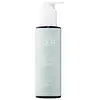What's inside
What's inside
 Key Ingredients
Key Ingredients

 Benefits
Benefits

 Concerns
Concerns

 Ingredients Side-by-side
Ingredients Side-by-side

Water
Skin ConditioningCocamidopropyl Betaine
CleansingDisodium Cocoamphodipropionate
CleansingSodium Lauroyl Sarcosinate
CleansingSodium Lauryl Sulfoacetate
CleansingPropanediol
SolventSodium Coco Pg-Dimonium Chloride Phosphate
CleansingCaprylyl Glycol
EmollientPolyquaternium-10
Fructosyl Cocoate/Olivate
EmollientSodium Chloride
MaskingGlyceryl Laurate
EmollientPhenoxyethanol
PreservativeSodium Cocoyl/Olivoyl Hydrolyzed Oat/Wheat Protein
CleansingPotassium Sorbate
PreservativeAllantoin
Skin ConditioningPanthenol
Skin ConditioningCocamidopropyl Dimethylamine
EmulsifyingSodium Glycolate
BufferingHexylene Glycol
EmulsifyingCitric Acid
BufferingCocoyl Hydroxyethyl Imidazoline
Methyl Alcohol
SolventLavandula Angustifolia Oil
MaskingAlgae Extract
EmollientCocos Nucifera Oil
MaskingGardenia Taitensis Flower Extract
Skin ConditioningTocopherol
AntioxidantPhyllanthus Emblica Fruit Extract
HumectantLinalool
PerfumingWater, Cocamidopropyl Betaine, Disodium Cocoamphodipropionate, Sodium Lauroyl Sarcosinate, Sodium Lauryl Sulfoacetate, Propanediol, Sodium Coco Pg-Dimonium Chloride Phosphate, Caprylyl Glycol, Polyquaternium-10, Fructosyl Cocoate/Olivate, Sodium Chloride, Glyceryl Laurate, Phenoxyethanol, Sodium Cocoyl/Olivoyl Hydrolyzed Oat/Wheat Protein, Potassium Sorbate, Allantoin, Panthenol, Cocamidopropyl Dimethylamine, Sodium Glycolate, Hexylene Glycol, Citric Acid, Cocoyl Hydroxyethyl Imidazoline, Methyl Alcohol, Lavandula Angustifolia Oil, Algae Extract, Cocos Nucifera Oil, Gardenia Taitensis Flower Extract, Tocopherol, Phyllanthus Emblica Fruit Extract, Linalool
Salicylic Acid 2%
MaskingWater
Skin ConditioningGlycerin
HumectantCapryl/Capramidopropyl Betaine
CleansingUrea
BufferingSodium C14-16 Olefin Sulfonate
CleansingShea Butteramidopropyl Betaine
CleansingPEG-150 Pentaerythrityl Tetrastearate
EmulsifyingLaureth-9
EmulsifyingSodium Lactate
BufferingNiacinamide
SmoothingEthoxydiglycol
HumectantSodium Chloride
MaskingGluconolactone
Skin ConditioningC12-13 Alkyl Lactate
EmollientCeramide NP
Skin ConditioningCeramide AP
Skin ConditioningCeramide EOP
Skin ConditioningCarbomer
Emulsion StabilisingSaccharide Isomerate
HumectantGlycolic Acid
BufferingCalcium Gluconate
HumectantSodium Benzoate
MaskingSodium Citrate
BufferingSodium Lauroyl Lactylate
EmulsifyingCholesterol
EmollientPhenoxyethanol
PreservativeDisodium EDTA
Tetrasodium EDTA
Citric Acid
BufferingHydrolyzed Hyaluronic Acid
HumectantLactic Acid
BufferingPhytosphingosine
Skin ConditioningXanthan Gum
EmulsifyingHexylene Glycol
EmulsifyingEthylhexylglycerin
Skin ConditioningBenzoic Acid
MaskingSalicylic Acid 2%, Water, Glycerin, Capryl/Capramidopropyl Betaine, Urea, Sodium C14-16 Olefin Sulfonate, Shea Butteramidopropyl Betaine, PEG-150 Pentaerythrityl Tetrastearate, Laureth-9, Sodium Lactate, Niacinamide, Ethoxydiglycol, Sodium Chloride, Gluconolactone, C12-13 Alkyl Lactate, Ceramide NP, Ceramide AP, Ceramide EOP, Carbomer, Saccharide Isomerate, Glycolic Acid, Calcium Gluconate, Sodium Benzoate, Sodium Citrate, Sodium Lauroyl Lactylate, Cholesterol, Phenoxyethanol, Disodium EDTA, Tetrasodium EDTA, Citric Acid, Hydrolyzed Hyaluronic Acid, Lactic Acid, Phytosphingosine, Xanthan Gum, Hexylene Glycol, Ethylhexylglycerin, Benzoic Acid
 Reviews
Reviews

Ingredients Explained
These ingredients are found in both products.
Ingredients higher up in an ingredient list are typically present in a larger amount.
Citric Acid is an alpha hydroxy acid (AHA) naturally found in citrus fruits like oranges, lemons, and limes.
Like other AHAs, citric acid can exfoliate skin by breaking down the bonds that hold dead skin cells together. This helps reveal smoother and brighter skin underneath.
However, this exfoliating effect only happens at high concentrations (20%) which can be hard to find in cosmetic products.
Due to this, citric acid is usually included in small amounts as a pH adjuster. This helps keep products slightly more acidic and compatible with skin's natural pH.
In skincare formulas, citric acid can:
While it can provide some skin benefits, research shows lactic acid and glycolic acid are generally more effective and less irritating exfoliants.
Most citric acid used in skincare today is made by fermenting sugars (usually from molasses). This synthetic version is identical to the natural citrus form but easier to stabilize and use in formulations.
Read more about some other popular AHA's here:
Learn more about Citric AcidHexylene Glycol is a surfactant. Glycols are a class of alcohols. Hexylene Glycol is a surfactant and emulsifier.
As a surfactant, Hexylene Glycol helps gather dirt and oil on your skin to be washed away.
As an emulsifier, Hexylene Glycol helps keep water and oil together. This prevents them from separating in a product. Hexylene Glycol also thins out the texture of a product by lessening viscosity.
Hexylene Glycol has a small molecular weight.
Learn more about Hexylene GlycolPhenoxyethanol is a preservative that has germicide, antimicrobial, and aromatic properties. Studies show that phenoxyethanol can prevent microbial growth. By itself, it has a scent that is similar to that of a rose.
It's often used in formulations along with Caprylyl Glycol to preserve the shelf life of products.
Chances are, you eat sodium chloride every day. Sodium Chloride is also known as table salt.
This ingredient has many purposes in skincare: thickener, emulsifier, and exfoliator.
You'll most likely find this ingredient in cleansers where it is used to create a gel-like texture. As an emulsifier, it also prevents ingredients from separating.
There is much debate on whether this ingredient is comedogenic. The short answer - comedogenic ratings don't tell the whole story. Learn more about comegodenic ratings here.
The concensus about this ingredient causing acne seems to be divided. Research is needed to understand if this ingredient does cause acne.
Scrubs may use salt as the primary exfoliating ingredient.
Learn more about Sodium ChlorideWater. It's the most common cosmetic ingredient of all. You'll usually see it at the top of ingredient lists, meaning that it makes up the largest part of the product.
So why is it so popular? Water most often acts as a solvent - this means that it helps dissolve other ingredients into the formulation.
You'll also recognize water as that liquid we all need to stay alive. If you see this, drink a glass of water. Stay hydrated!
Learn more about Water